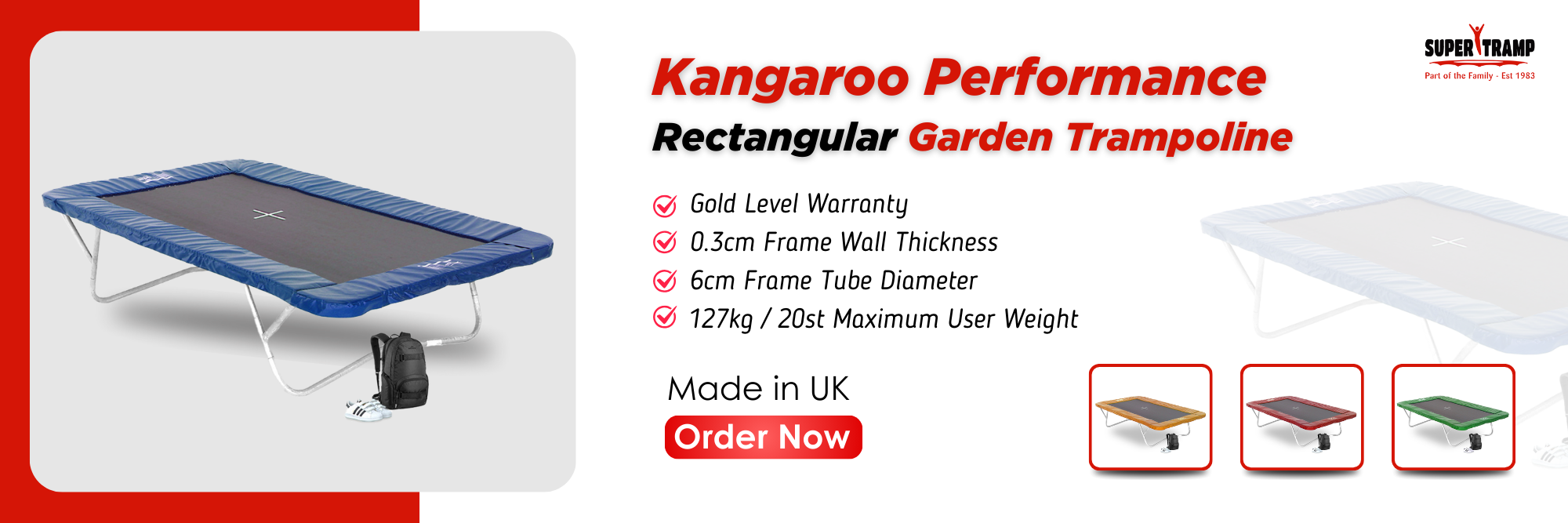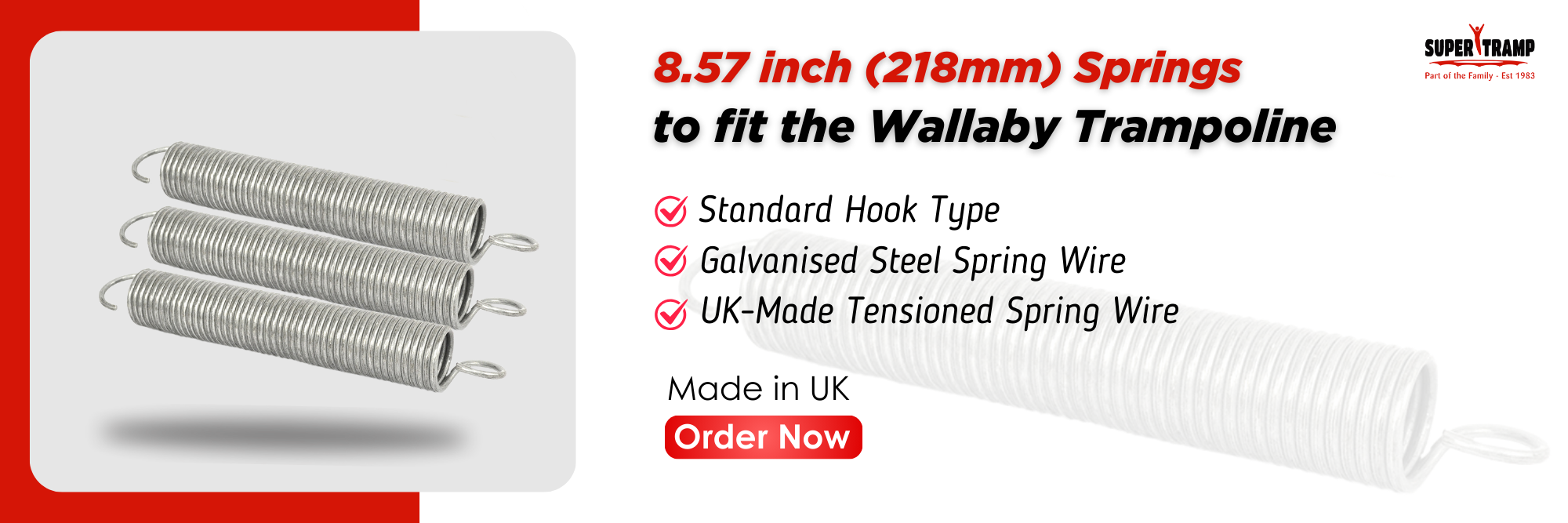Choosing the perfect trampoline can be a daunting task, especially when you’re faced with a variety of options. It’s easy to feel overwhelmed. With so many choices, finding the right one for your garden can quickly become confusing. This is particularly true when deciding between a spring trampoline or spring-free trampoline.
Table of Contents
ToggleWhen shopping for an outdoor rectangular or round trampoline, you might think that one is as good as the other—they’re both trampolines, after all. But hold on—each type has its unique pros and cons, and making the wrong choice could lead to regrets. That’s why we’re here to help you navigate through the details and make an informed decision.

Understanding the differences between spring and spring-free trampolines will empower you to choose the best option for your family. After all, a well-informed choice can turn your purchase into a worthwhile investment, ensuring every penny you spend is put to good use. So, before you make that final decision, take a moment to immerse yourself in the details with us fully. We’re here to guide you with accurate and transparent information because your investment matters—and we want to ensure it’s worth every cent.
What is a Spring Trampoline?
Whether you’re a child of the 20th century or navigating the 21st, the spring trampoline remains a top pick for its unbeatable combination of fun and resilience. If you were born in the 2000s, this guide will likely spark nostalgia, as just hearing the word “trampoline” might instantly bring back fond memories of endless hours spent bouncing in your garden. Remember those carefree days? There’s something timeless about the classic spring trampoline, a piece of equipment that has been a staple in countless childhoods.
From the echoes of your childhood to the present day, trampolines continue to be a central part of many people’s best memories. They say old is gold, and when it comes to spring trampolines, that couldn’t be truer. These trampolines exemplify durability and performance, qualities that have stood the test of time and continue to make them a cherished choice for outdoor fun.
A garden trampoline with spring is built with a simple yet effective structure: a sturdy frame, a bouncy mat, and, of course, the iconic metal springs that connect the two. These springs are what give the trampoline its distinct, energetic bounce. Surrounding the mat is protective padding, designed to shield jumpers from the hard springs and frame, ensuring a safer experience.
Invented by George Nissen and Larry Griswold at the University of Iowa, spring trampolines quickly gained popularity after their creation. Over the decades, they have evolved from being just a garden plaything to becoming an essential tool in fitness, sports, and even astronaut training. Yes, you read that right—NASA has used spring trampolines to help train astronauts. The benefits go far beyond fun: they’re also excellent for improving balance, aiding weight loss, and even helping individuals with ADHD or stroke recovery.
The memories you’re recalling are more than justified. The trampoline you love for its pure fun also offers a range of physical and mental health benefits. And that’s just the beginning. There’s so much more to discover about spring trampolines, so keep reading as we will take a closer look into everything you need to know about this cherished piece of equipment.
But as promised, we’re here to be transparent, fair, and accurate. So now, let’s take a look at the new innovation in the trampoline world—the Springfree trampoline.
What is a Springfree Trampoline?
Change is a natural part of progress, and in the early 21st century, Dr. Keith Alexander introduced the Springfree trampoline as a new approach to trampoline design. Unlike safe spring trampolines that use metal springs, Springfree trampolines use flexible composite rods, bungee cords, or elastic straps to create the bounce. This design removes the need for springs and changes how the trampoline looks and functions.
More than safety, Springfree trampolines focus heavily on appearance. Their streamlined design enhances the visual appeal of any garden. With clean lines and a minimalist aesthetic, these trampolines are crafted to blend seamlessly into outdoor spaces, making them an attractive addition to any garden.
However, it’s worth noting that Springfree trampolines may offer a more rigid surface compared to spring trampolines. This design can result in a bounce that absorbs less force, which some users find less forgiving on the body when landing. Despite this, Springfree trampolines remain popular due to their aesthetic integration into garden settings.
Now that we’ve explored what sets Springfree trampolines apart, let’s look into the key differences between traditional spring trampolines and their springless counterparts.
Differences Between Spring and Springfree Trampolines
When it comes to choosing between spring and Springfree trampolines, understanding the key differences can help you make a more informed decision. While both options have their merits, let’s explore why traditional spring trampolines might just be the better choice for your family.
Safety
- Spring Trampoline: 10ft trampolines with spring have indeed exposed springs and metal frames, but with proper padding and safety nets, these risks are significantly reduced. Spring trampolines are designed with keeping safety as its top priority. Many users appreciate the tried-and-true design that allows for a sturdy and reliable bounce, with modern enhancements making safety a top priority.
- Springfree Trampoline: While Springfree trampolines remove the risk of exposed springs by using flexible rods, this doesn’t mean they’re entirely risk-free. The absence of springs does create a different kind of bounce, but some users find that the trade-off in bounce quality isn’t worth it.
Bounce Quality
- Spring Trampoline: 14ft trampolines with spring offer a firm, responsive bounce that’s difficult to match. The metal springs provide a consistent and energetic rebound, making every jump feel exhilarating. This traditional bounce is what many people are accustomed to and is often preferred for its familiar and enjoyable experience.
- Springfree Trampoline: The Springfree trampoline has soft bounce, due to its flexible rods, and can feel less dynamic. For those seeking a trampoline that delivers the classic, lively bounce, spring trampolines remain the superior choice.
Durability and Maintenance
- Spring Trampoline: With proper care, a fitness trampoline with spring can last for years. Regular maintenance, such as checking for rust or wear on the springs, ensures they stay in top condition. The durable design of these trampolines means they can withstand heavy use, making them a long-lasting investment.
- Springfree Trampoline: Springfree trampolines require brand-specific replacement parts, such as flexible rods, which can only be purchased directly from the manufacturer. This can limit your options and potentially lead to higher costs and longer wait times for repairs.
Cost
- Spring Trampoline: One of the biggest advantages of performance trampoline with spring is their affordability. With a wide range of price points, there’s a spring trampoline to fit nearly every budget. You get great value for your money, especially when you consider the durability and performance they offer.
- Springfree Trampoline: The advanced design and materials of Springfree trampolines come with a higher price tag. While some may justify the cost for the safety features, others might find it hard to justify spending significantly more when spring trampolines offer excellent performance at a lower cost.
Aesthetic and Space Considerations
- Spring Trampoline: 11ft trampoline with spring has a classic look that many people find appealing. They come in various sizes and can fit well into different garden settings. Plus, their design has a nostalgic charm that can add character to your outdoor space.
- Springfree Trampoline: While Springfree trampolines have a sleek and modern appearance, their larger footprint and unique design might not suit every garden. The aesthetic appeal of spring trampolines can often be a better match for traditional and contemporary gardens alike.
Use in Trampoline Parks
- Spring Trampoline: When it comes to commercial use, spring trampolines are the go-to choice for trampoline parks. Their robust design and reliable bounce make them ideal for high-traffic areas, ensuring safety and fun for all users. Springfree trampolines, on the other hand, are still not widely adopted in trampoline parks, which speaks to the trust and preference for spring-based models in professional settings.
As you weigh your options, it’s clear that spring trampolines offer a balance of safety, performance, and value that’s hard to beat. Their long-standing popularity, ease of maintenance, and the ability to easily replace parts make them a trusted choice for families looking for a trampoline that delivers both fun and durability. So, if you’re looking for a trampoline that offers the best bounce, cost-effectiveness, and versatility, a spring trampoline might just be the perfect fit for your garden.
Do not forget to visit the top trampoline brand to find the best spring trampoline for your garden.
Conclusion
Now that you’re fully equipped with all the essential information, you’re ready to make the perfect choice for your garden oasis. Just like choosing the right tool for a job, selecting the ideal trampoline comes down to understanding your priorities—whether it’s safety, cost, or that perfect bounce.
At the end of the day, your choice should reflect what matters most to you and your family. Do you want the tried-and-true performance of a spring trampoline, with the flexibility to replace parts as needed, aesthetic garden look, loaded with so many fitness, mental and rehab benefits? Or are you more drawn to the soft bounce of a Springfree trampoline?
Whatever you decide, remember that investing in a trampoline is more than just a purchase; it’s about creating joyful, active moments in your garden. So, wave goodbye to confusion and say hello to endless happy bouncing times ahead. Your garden is waiting, and the perfect trampoline is out there—just ready to make every jump count.
Spring trampolines offer a higher bounce and traditional experience, often preferred for their affordability and reliability, whereas springfree trampolines prioritise safety with a different design.
Yes, spring trampolines are safe when used with proper safety nets and padding, providing a secure environment for jumping.
The safest children of trampoline is one with a robust safety net and padding, like a well-maintained spring trampoline with high-quality springs.
Springfree trampolines are expensive due to their unique design and materials, but a spring trampoline can offer great safety features at a more affordable price.
Weather exposure, lack of maintenance, and improper use can ruin a spring trampoline, but with proper care, they can last many years.





